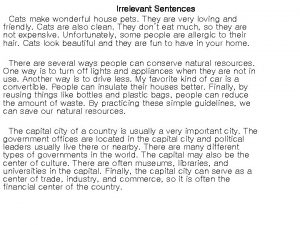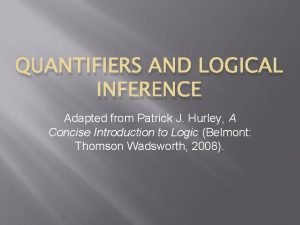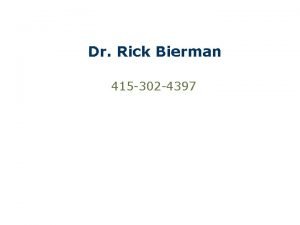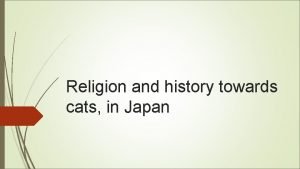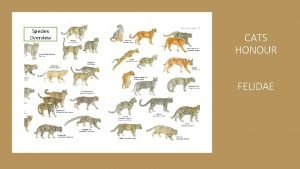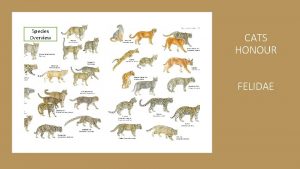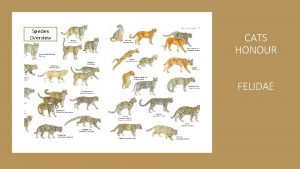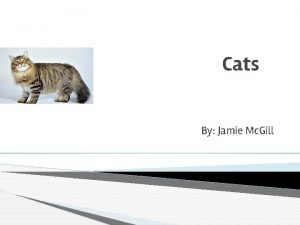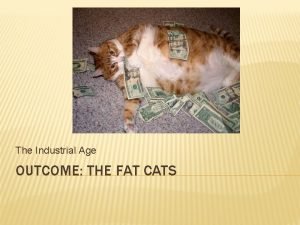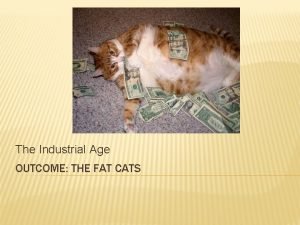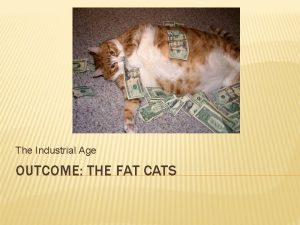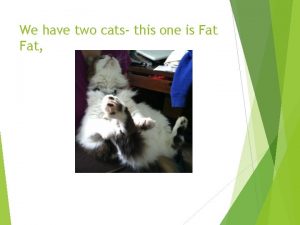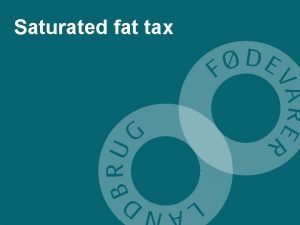THE FAT CATS US History The Fat Cats




































- Slides: 36

THE FAT CATS US History

The Fat Cats… Setting the Stage 1. a. b. c. d. e. Also known as Captains of Industry, Industrial Giants, and Robber Barons Wealth fell into the hands of a few By 1890 – 4, 000 millionaires Approximately 90% of & (wealth and assets) controlled by 10% of the population 1900 = 20 million Americans lived in poverty (very small middle class)

Cornelius Vanderbilt

The Fat Cats… 2. Who were they? Cornelius Vanderbilt a. i. iii. iv. v. vi. vii. Started out in shipping, buying his first ferry boat at age 16 Eventually had large fleet of ferries and ocean steamships Saw railroads as the future; bought many RRs before and after the Civil War Became wealthiest man in America Built Grand Central Depot in NYC Made a deal with John Rockefeller to transport his oil Would have been worth $143 billion in modern times

Grand Central Depot in NYC

Grand Central Depot in NYC

Biltmore Estate in North Carolina

Biltmore Estate in North Carolina

John D. Rockefeller

Standard Oil Became Amoco Oil

The Fat Cats… 2. Who were they? John D. Rockefeller b. i. iii. iv. v. Founded Standard Oil Company in 1870 By 1880 90% monopoly; nation’s first billionaire Drove out competition by selling oil at a lower price than it cost to produce Raised prices once he controlled the market Gave away $500 million dollars




Rockefeller Center in NYC

Andrew Carnegie

The Fat Cats… 2. Who were they? Andrew Carnegie c. i. iii. iv. v. Rags to riches: born to poor Scottish family who immigrated to the United States Worked his way to become private secretary to the local superintendent of the Pennsylvania Railroad Entered the Steel business in 1887 Controlled 25% of United States steel production Sold his steel business to JP Morgan in 1901


James J. Hill

The Fat Cats… 2. Who were they? James J. Hill d. i. iii. iv. Canadian born but settled in St. Paul, Minnesota “Empire Builder” used no government land grants Built Great Northern Railroad from Duluth, Minnesota to Puget Sound, Washington Home in St. Paul belongs to Minnesota Historical Society

James J. Hill House in St. Paul

James J. Hill House in St. Paul

JP Morgan

The Fat Cats… 2. Who were they? JP Morgan e. i. iii. iv. Was known as the “Giant of Finance” Began his career as a an accountant Was a banker and a great organizer of companies like GE and AT&T Bought Carnegie Steel in 1901; renamed it US Steel

The Fat Cats… 3. How did they become rich? a. Opportunity – a pure capitalist system allows for unlimited economic opportunity, but no guarantees b. Laissez-faire government meant unchecked free enterprise i. ii. Hands off attitude toward business/industry/economy No income tax (not made law until 1913, 16 th amendment)

The Fat Cats… How did they become rich? 3. Labor abuses were permitted c. i. ii. d. No safety codes, no minimum wage Unions were rare, even illegal Monopolies formed (goal: to rid competition and control prices)

The Fat Cats… 3. How did they become rich? Monopolies formed (goal: to rid competition & control prices) d. i. Integration tactics 1. 2. ii. Vertical integration: buying up resources, transportation, etc Horizontal integration: merging like companies together Bribery and Corruption 1. 2. Rockefeller forced RR’s to pay him rebates on shipping Political (bribing US Senate = millionaire’s club)

The Fat Cats… 3. How did they become rich? Improved Technology meant increased efficiency in: e. i. Farming (Mc. Cormick’s Reaper & John Deere’s steel plow) 1. 2. ii. By 1880, 1 farmhand could harvest 135 acres a day on average Young men migrated to cities adding to the industrial labor supply Business & Industry i. ii. Edison – light bulb, stock ticker, etc Bell – telephone, Sholes, typewriter

The Fat Cats… How did they become rich? 3. Corporations (Publically held companies) were formed f. i. iii. Quick method of raising capital ($) for growth and expansion Reduced risk (spread out among stockholders) Ensures the longevity (life) of the company

Mc. Cormick’s Reaper

Thomas Edison

Sholes’ Typewriter

The Fat Cats… 3. How did they become rich? Social Darwinism – “rich were meant to be rich” g. i. ii. Life is a struggle and the poor are just weak and/or lazy Justified a “hunt and kill” method to acquire wealth and power

The Fat Cats… 3. How did they become rich? Government Actions h. i. ii. Land grants were used to encourage railroad construction and settlements Protective tariffs placed a tax on imported goods that compete with US goods

Philanthropy and the Gospel of Wealth

The Fat Cats… Some became believers in Carnegie’s “Gospel of Wealth” 4. Rich have an obligation to improve society with their fortunes Philanthropy: an active effort to improve society through contributions of one’s own wealth Examples: a. b. c. 1. 2. 3. Carnegie: built many libraries and Carnegie Hall in NYC Rockefeller: donated $550 million dollars to many universities Morgan: donated $20 million to University of the South, $10 million to Harvard
 John d. rockefeller iii
John d. rockefeller iii Trans fat vs cis fat
Trans fat vs cis fat Examples of invisible fat
Examples of invisible fat Cinquain poems
Cinquain poems Poems ideas
Poems ideas Normal alt in cats
Normal alt in cats Genetic drift
Genetic drift Smarty cats drop in tutoring
Smarty cats drop in tutoring Cats make wonderful house pets
Cats make wonderful house pets Herding cats project management
Herding cats project management It is raining cats and dogs figure of speech
It is raining cats and dogs figure of speech I has two cats
I has two cats Tongue twisters about cats
Tongue twisters about cats Cats of borneo chronological order
Cats of borneo chronological order Symbolize the statement “all cats are animals”.
Symbolize the statement “all cats are animals”. Amaurotic cats eye reflex
Amaurotic cats eye reflex The definition of morphology
The definition of morphology Cats rvc
Cats rvc Journal of a lumpy kid by ken jiffy
Journal of a lumpy kid by ken jiffy Edgar allan poe the black cat meaning
Edgar allan poe the black cat meaning Cats of borneo chronological order
Cats of borneo chronological order Cats of borneo chronological order
Cats of borneo chronological order Puccini cat duet
Puccini cat duet Kennings for cats
Kennings for cats Russian cat breeds
Russian cat breeds On a ski lift the chairs are equally spaced
On a ski lift the chairs are equally spaced Kenninga
Kenninga The day they parachuted cats into borneo food web
The day they parachuted cats into borneo food web If 6 cats can kill 6 rats in 6 minutes
If 6 cats can kill 6 rats in 6 minutes Stages of morgellons disease pictures
Stages of morgellons disease pictures Cats
Cats When everyone has short hair rebels want
When everyone has short hair rebels want Nedbank credit card travel insurance 2019
Nedbank credit card travel insurance 2019 Fpv in cats
Fpv in cats Change talk worksheet
Change talk worksheet Intramuscular injection sites in dogs and cats
Intramuscular injection sites in dogs and cats It rained cats and dogs figure of speech
It rained cats and dogs figure of speech








